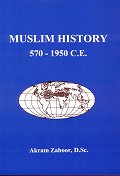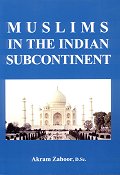[Excerpted from Prof B. N. Pande's speech in the Indian Upper House of Parliament, the Rajya Sabha, made on 29 July 1977. At the time of the publication of this article in Impact International (1987), Dr Pande was Governor of the Indian state of Orrisa. Dr. Pande died in New Delhi on June 1, 1998.]

Thus under a definite policy the Indian history text-books were so falsified and distorted as to give an impression that the medieval period of Indian history was full of atrocities committed by Muslim rulers on their Hindu subjects and the Hindus had to suffer terrible indignities under Islamic rule. There were no common factors in social, political or economic life.
Excerpts
I have the honour to move the following resolution for the consideration of this House:
'This House is of the opinion that the main factor retarding cultural and emotional integration of the Indian people is the communal interpretation of the medieval Indian history and its distortion by the British historians, while India was under British rule, portraying the Hindus and the Muslims as being divided into two warring camps with little in common between them, and that this distortion paved the way for the emergence of the two-nation theory, and therefore recommends that the government should take immediate steps for the re-orientation of the study of Medieval Indian History ...'
The task is not easy, because unfortunately the histories of India which have been taught in our schools and colleges for generations past were originally compiled by European writers. And Indians have not yet succeeded in shaking off the biases inclucated by their European teachers. These so called histories have presented Muslims as destroyers of Hindu culture and traditions; despoilers of Hindu temples and palaces; and brutal idol-breakers who have offered to their Hindu victims the terrible alternative of conversion or the sword.
It is hardly surprising that educated men in India drugged with such poisonous stuff from the most impressionable period of their lives grow up to suspect and distrust each other. The Hindu has been brought up to believe that the Muslim period of Indian history which extends over eight hundred years and more is a nightmare.
How British historians have used these sentiments would be clear from the following quotation from the well-known compilation, Sir H. M. Elliot's 'History of India as told by its own historians'. The passage occurs in the general preface to Volume 1. I quote -
'We behold kings ... sunk in sloth or debauchery and emulating the vices of a Caligula or a Commodus.
'Under such rulers we cannot wonder that fountains of justice are corrupted: that the state revenues are never collected without violence and outrage; that villages are burnt and their inhabitants mutilated or sold into slavery; that the officials far from affording protection, are themselves the chief robbers and usurpers, that parasites and eunuchs revel in the spoils of plundered provinces, and that the poor find no redress against the oppressor's wrong and proud man's contumely. The few glimpses we have even among the short extracts of this single volume of Hindus slain for disputing with Muhammadans, of a general prohibition against processions, worship or ablutions and other intolerant measures, of idols mutilated, or temples razed, of forcible conversions and marriages, of proscriptions and confiscations, of murders and massacres and of the sensuality and drunkness of the tyrants who enjoined them, show us that this picture is not over-charged'.

A glimpse into official British records will show how this policy of Divide-et-Impera was taking shape. The Secretary of State Wood in a letter to Lord Elgin [Governor General Canada (1847-54) and India (1862-63)] said: 'We have maintained our power in India by playing off one part against the other and we must continue to do so. Do all you can, therefore to prevent all having a common feeling.’
George Francis Hamilton, Secretary of State of India wrote to Curzon, ‘I think the real danger to our rule in India not now, but say 50 years hence is the gradual adoption and extension of Western ideas of agitation organisation and if we could break educated Indians into two sections holding widely different views, we should, by such a division, strengthen our position against the subtle and continuous attack which the spread of education must make upon our system of government. We should so plan educational text-books that the differences between community and community are further strengthened (Hamilton to Curzon, 26th March 1886).
Cross informed the Governor-General, Dufferin, that 'This division of religious feeling is greatly to our advantage and I look for some good as a result of your Committee of Inquiry on Indian Education and on teaching material' (Cross to Dufferin, 14 January, 1887).
Thus under a definite policy the Indian history text-books were so falsified and distorted as to give an impression that the medieval period of Indian history was full of atrocities committed by Muslim rulers on their Hindu subject and the Hindus had to suffer terrible indignities under Islamic rule. There were no common factors in social, political or economic life.

While I was doing some research on Tippu Sultan in 1928 at Allahabad, some office bearers of a college Students Union approached me with a request to inaugurate their History Association. They had directly come from the college with their text-books. I opened the chapter on Tippu Sultan. One of the sentences that struck me deeply was: 'Three thousand Brahmins committed suicide as Tippu wanted to convert them forcibly into the fold of Islam'. The author of the text-book was, Mahamahopadhyaya Dr. Har Prashad Shastri, Head of the Department of Sanskrit, Calcutta University. I immediately wrote to Dr. Shastri for the source of his information. After many reminders came the reply that he had taken that from the Mysore Gazetteer....
... Prof Srikantia informed me that the episode of the suicide of 3,000 Brahmins is nowhere in the Mysore Gazetteer and he, as student of history of Mysore, was quite certain that no such incident had taken place. He further informed me that the Prime Minister of Tippu Sultan was a Brahmin named Punaiya and his commander-in-chief was also a Brahmin, named Krishna Rao. He supplied me with the list of 156 temples to which Tippu Sultan used to pay annual grants. He sent me 30 photostat copies of Tippu Sultan's letters addressed to the Jagadguru Shankaracharya of Srinageri Math with whom Tippu Sultan had very cordial relations....
Dr Shastri's book was approved as a course book of history for high schools in Bengal, Assam, Bihar, Orissa, U.P., M.P. and Rajasthan. I approached Sri Ashutosh Mukherjee, the then Vice-Chancellor of Calcutta University, and sent him all the correspondence that I had exchanged with Dr Shastri, with Mysore University Vice-Chancellor, Sri Brijendra Nath Seal, and Prof. Srikantia, with the request to take proper action against the offending passages in the text-book. Prompt came the reply from Sri Ashutosh Mukherjee, that the history book by Dr Shastri has been put out of course.
However, I was amazed to find the same suicide story was still existing in the history text-books which had been prescribed in 1972 for Junior High Schools in U.P.

When I was the Chairman of the Allahabad Municipality I came across the dispute regarding the property of the Someshwar Nath Mahadev mandir. There were two rival claims, one of which prepared a file of Farmans issued, by Emperor Aurangzeb which confirmed the issue of a Jagir for the temple. I was shocked to find this reference regarding a man who is supposed to have been a destroyer of temples. At first I was inclined to believe that these (Farmans) were forgeries.
However, before I reached a definite conclusion, I thought it to be in order to consult Sir Tej Bahadur Sapru, a renowned scholar of Persian language. Sir Sapru studied the Jagdambri Shiv Mandir documents and again found Farmans of Aurangzeb which bestowed a Jagir on this temple. A new Aurangzeb was unveiled before me and through further research and investigation, I discovered many more Farmans of like nature with regard to Mahakaleswar temple in Ujjain, Balaji Temple in Chitrakoot, Amparand Temple in Gauhati, Shatranjay Jain Temple and various Gurdwaras. These Farmans were issued between the year 1656 and 1686. [Aurangzeb's father Emperor Shah Jahan is famous for having built the Taj Mahal, considered as one of the wonders of the world]....
The story regarding demolition of Vishwanath temple is that while Aurangzeb was passing near Varanasi on his way to Bengal, the Hindu Rajas in his retinue requested that if a halt is made for a day, their Ranis may go to Varanasi, have a dip in the Ganges and pay their homage to Lord Vishwanath. Aurangzeb readily agreed.
The Ranis took their dip in the Ganges and went to the Vishwanath temple to pay their homage. All the Ranis returned except one, the Maharani of Kachh. When Aurangzeb came to know of it, he was very much enraged. He sent his senior officers to search for the Rani. Ultimately, they found that the Statue of Ganesh which was fixed in the wall was a movable one. When the statue was moved a flight of stairs led to the basement. To their horror, they found the missing Rani dishonoured and crying. The basement was just beneath Lord Vishwanath's seat. The Hindu Rajas expressed their vociferous protests. They demanded justice. Aurangzeb ordered that Lord vishawanath may be moved to some other place, the temple be razed to the ground and the Mahant be arrested and punished.
Dr Pattabhi Sitaramaiah, in his famous book 'The Feathers and the Stones' has narrated this fact based on documentary evidence. Dr. P. L. Gupta, former Curator of Patna Museum has also narrated this incident ...
Every civil building connected with Mahommedan tradition should be levelled to the ground without regard to antiquarian veneration or artistic predilection.
Letter No. 9 dated 9 October 1857, from Prime Minister Palmerston (1784-1865) to
Lord Canning Viceroy of India, Canning Papers.


Courtesy: Impact International, London, August 1987, Copyright © 1987.
E-Books on Islam and Muslims
http://cyberistan.org/islamic/pande.htm
![]()
![]()
![]()
![]()